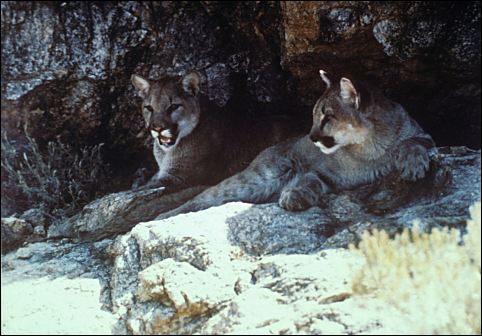

The mountain lion, Felis concolor, has many common names: puma, cougar, panther, and catamount; but whatever you call it, it is one of the region's most feared and persecuted, although rarely seen, predators. It is the widest-ranging big cat in the New World, found from British Columbia to Patagonia. Locally, hunting pressures and environmental changes have restricted its range to mountainous and uninhabited regions.
Mountain lions are carnivores, their prey consisting mainly of deer and
other large game, but smaller prey such as rabbits, skunks, and raccoons are taken if
needed. Due to hunting, lion populations hit extremely low numbers in the early 1900s,
because hunters believed they had a negative effect on wild game populations. As a
result, deer populations grew unchecked, with adverse effects on the habitat as well as
on the health of deer populations, since lions usually cull the sick or weak. Ranchers
also fear mountain lions although they rarely attack livestock. Hopefully, the more we
know about this elusive predator, the less they will be feared and the more they will
be appreciated.

Contributor: Eric A. Trum, Student, University of Texas at El Paso.
Desert Diary is a joint production of the Centennial Museum and KTEP National Public Radio at the University of Texas at El Paso.

Mountain Lions (Felis concolor. Image courtesy of the U.S. Fish and Wildlife
Service. ![]()
The Mountain Lion generally is now (2012) recognized as a member of the genus Puma, rather than Felis. Thus the scientific name is Puma concolor.
Currier, M. J. P. 1983. Felis concolor. Mammalian Species No. 200:1-7. American Society of Mammalogists.
Eaton, R. L., and K. A. Verlander. 1977. Reproduction in the puma: biology, behavior, and ontogeny. Pp. 435-470. in: R. L. Eaton (ed). The World's Cats. Vol. 3, No. 3. Seattle: Carnivore Research Institute, Burke Museum, University of Washington.